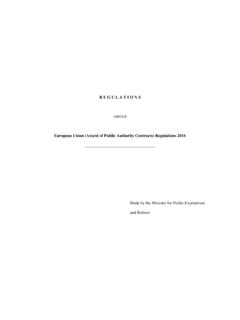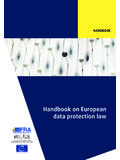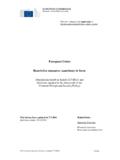Transcription of FINANCIAL REGULATION IN THE EUROPEAN UNION
1 F I N A N C I A L R E G U L A T I O N I N T H E E U R O P E A N U N I O N M A P P I N G E U D E C I S I O N M A K I N G S T R U C T U R E S O N F I N A N C I A L R E G U L AT I O N A N D S U P E RV I S I O N Myriam Vander Stichele - SOMO December 2008 With support from the Ford Foundation T H I S R E P O R T W A S C O M M I S S I O N E D B Y : B R E T T O N W O O D S P R O J E C T C A M P A G N A P E R L A R I F O R M A D E L L A B A N C A M O N D I A L E E U R O D A D W E E D 2 A B O U T T H I S R E P O R T This research document reflects a short study to provide an oversight in the main bodies and processes of decision making about FINANCIAL REGULATION and supervision at the EU level.
2 The document aims at providing the basis for a better insight about the influence of EU decisions regarding FINANCIAL matters within Europe and in developing countries. This paper aims to help strategic discussions by NGOs interested in undertaking advocacy on the reform of the FINANCIAL system, and particularly its consequences on developing countries. The research was undertaken between July and November 2008. It was commissioned by the EUROPEAN Network on Debt and Development, WEED, Bretton Woods Project and Campagna per la Reforma della Banca Mondiale. This report has been made possible through the generous financing of the Ford Foundation which is supporting a project on Shaping EUROPEAN governance of global finance.
3 Further reports and articles produced as part of this project are available at: This document does not aim to give a full evaluation of the EUROPEAN FINANCIAL architecture and its impact on the developing world. However, the FINANCIAL crisis that erupted in Europe in September 2008 has clearly exposed the weaknesses of the EUROPEAN regulatory and supervisory system, and the resulting economic crisis has affected many parts of the world. A B O U T T H E A U T H O R Myriam van der Stichele is senior researcher at SOMO, the Centre for Research on Multinational Corporations. She has an in International Relations from Cambridge University and has been monitoring international trade negotiations and agreements since 1990. Her recent research has focused on the FINANCIAL , food and supermarkets sectors, and the corporate strategies and services liberalisation related to these.
4 She has written many reports and contributed to several books. The publications list is available at: 3 TA B L E O F C O N T E N T S About this report .. 2 About the author .. 2 LIST OF ABBREVIATIONS .. 5 FOREWORD .. 6 SUMMARY .. 8 CHAPTER 1: EUROPEAN Institutions Mandates on FINANCIAL REGULATION and Supervision .. 10 : The Role of the EUROPEAN Commission .. 10 Box I: Operational Information on DG Internal Market and Services/ DG Markt .. 11 Box II: Organisational Structure of Advisory Bodies with Member State Representatives, in the Lamfalussy 15 : The EC and Competition Issues .. 18 : The Role of the Council of the EUROPEAN UNION Regarding FINANCIAL regulations and Stability .. 20 : Ad Hoc Crisis Management by Heads of 24 : The Role of the EUROPEAN 26 : National Supervisors and Their Regulators.
5 29 : The Role of the EUROPEAN Central Bank .. 30 Box III: Article 105 of the Treaty of Nice .. 31 CHAPTER 2: Interaction Between the 34 : The Form of EU Legislation Influences the Influence by the Member 34 : Interaction Between the Council, the Member States and the EC .. 35 : The Relation Between the EUROPEAN Parliament (EP) and the EC and the Council .. 37 : The ECB: Present in Many Committees .. 38 : Conclusion .. 38 CHAPTER 3: The FINANCIAL Lobby and Influence of other Stakeholders .. 39 4 : Imbalanced Influence by Stakeholders .. 39 : Lobby Activities by the FINANCIAL Industry .. 40 : Academics and the EC Decision-Making Bodies .. 44 CHAPTER 4: Regulatory and Supervisory Achievements of EU Decision-Making 46 : Regulatory and Supervisory 46 : Issues on Which the EU is Currently 46 : Assessment of EU FINANCIAL Architecture Functioning and Weaknesses.
6 48 CHAPTER 5: EU Representation in International FINANCIAL Institutions and Trade Negotiations .. 51 : EUROPEAN Representation at International FINANCIAL Institutions .. 52 : Liberalisation of FINANCIAL Services in the World Trade Organisation and Free Trade Agreements .. 55 CHAPTER 6: The Impact on Developing Coutnries .. 60 CONCLUSIONS .. 62 LIST OF LITERATURE .. 64 ANNEXES .. 66 Annex I: Main Actions Proposed as a Conclusion of the Evaluation of the Lamfalussy Process by the 66 Annex II: Consultations on Line by DG Markt (Internal Market and Services) .. 68 Annex III: The Achievements of the Lamfalussy Process .. 71 5 L I S T O F A B B R E V I A T I O N S CEBS Committee of EUROPEAN Banking Supervisors CEIOPS Committee of EUROPEAN Insurance and Occupational Pension Supervisors CESR Committee of EUROPEAN Securities Regulators COREPER Comit des repr sentants permanents.
7 Normally the final committee before documents are submitted to the Council, or decides on issues on which there is consensus and no need to present to ministers. It consists of representatives from EU member countries who are permanently based in Brussels CRD Capital Requirements Directive EBC EUROPEAN Banking Committee EC EUROPEAN Commission ECOFIN Economic and FINANCIAL Affairs Council of the EUROPEAN UNION EFC Economic and Finance Committee EIB EUROPEAN Investment Bank EIOPC EUROPEAN Insurance and Operational Pensions Committee EPFSF EUROPEAN Parliamentary FINANCIAL Services Forum ESC EUROPEAN Securities Committee ESFRC EUROPEAN Shadow FINANCIAL Regulatory Committee ESCB EUROPEAN System of Central Banks and its Banking Supervision Committee (BSC). FSAP FINANCIAL Services Action Plan FSC FINANCIAL Services Committee FSF The FINANCIAL Stability Forum FTA Free Trade Agreement GATS General Agreement on Trade in Services IIF Institute of International Finance IWGFC Interim Working Group on FINANCIAL Conglomerates UCITS Undertakings for Collective Investment in Transferable Securities WTO Word Trade Organisation 6 F O R E W O R D In the context of the unfolding FINANCIAL crises, a debate arose about the need for concerted EUROPEAN UNION action to mitigate the impacts and institute measures to prevent recurrence.
8 This has been the broadest debate about EUROPEAN UNION joint action since the establishment of the Euro zone ten years ago. Pictures of account holders queuing outside Northern Rock banks in the UK and the unprecedented nationalisation of some large Dutch and Belgian banks moved EUROPEAN civil society, the media and other stakeholders to question to what extent the EU is institutionally and politically ready to face the unprecedented challenge of the FINANCIAL crises. Major EUROPEAN governments have been promoting a strong liberalisation and deregulation of FINANCIAL markets at both EUROPEAN and international levels with the belief that this would strengthen EUROPEAN economic and monetary policies. They now recognise the problem of insufficient coordination between EUROPEAN supervisors and between EUROPEAN governments and regulators.
9 The case of Ireland and its prompt, unilateral, move to support its FINANCIAL sector is emblematic of the intrinsic competition among governments in the current EUROPEAN FINANCIAL system which does not allow the introduction of different policies that would better support public interest and the real economy. The coordination and concerted action by EUROPEAN governments have been poor despite an unprecedented number and type of meetings tested under the French Presidency. Meetings in the last four months of 2008 included the G4- EUROPEAN Commission meeting, the emergency EUROPEAN Council meeting on the crises before the G20, the common position taken by EUROPEAN governments at the extraordinary Washington G-20 Summit in mid-November. The complexity of the FINANCIAL REGULATION , decision-making processes about FINANCIAL market supervision and REGULATION have long remained obscure to most EUROPEAN civil society groups.
10 The Eurodad network together with three EUROPEAN NGOs active on FINANCIAL markets and FINANCIAL liberalisation issues for many years - WEED in Germany, CRBM in Italy and the Bretton Woods Project in the UK commissioned this study as the first systematic effort to shed light on this complex but crucial matter. We selected Myriam van der Stichele as the expert to write the study given her work on private banks at SOMO over many years. Her findings will be of broad interest to several EUROPEAN civil society circles. The report shows a fundamental lack of democracy, accountability and transparency in EUROPEAN decision-making processes on FINANCIAL market issues. This is clearly reflected in the inadequate and biased mandate of the EUROPEAN Central Bank, but also in the growing number of institutionalised and informal groupings which deal with FINANCIAL market issues and dominate the discourse and the formal decision-making processes.







